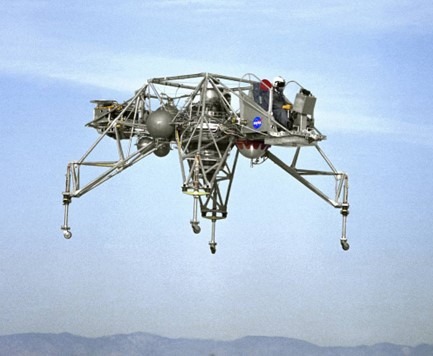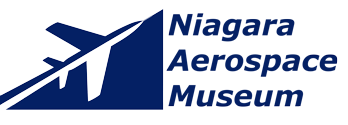
This month we highlight the Bell Lunar Landing Research Vehicle (LLRV) and Lunar Landing Training Vehicle (LLTV). While the museum doesn’t have an actual LLRV or LLTV on display, we have a scale model illustrating its unique propulsion system and expert docents happy to discuss this incredible piece of Western New York aerospace history.
Neil Armstrong’s task to land the Lunar Module on the Moon was unlike any piloting on earth ever performed since it took place in 1/6 Earth gravity with no aerodynamic lift or drag. So as early as 1961, before the design of the lunar lander itself was determined, a need was recognized for a pilot training vehicle. Conventional fixed-based visual simulators, helicopters, and a giant cable-suspended trainer at NASA Langley partially filled this requirement, but ultimately a free-flying vehicle was deemed necessary to provide sufficient fidelity in the piloting experience.
Thus were the Lunar Landing Research Vehicle (LLRV), and its close successor, the Lunar Landing Training Vehicle (LLTV) conceived by Bell Aerosystems of Niagara Falls, NY in coordination with NASA Flight Research Center (FRC). The odd-looking open-framed vehicles earned the nickname the “flying bedstead. The central feature was a vertically-mounted General Electric CF700 jet engine on a dual-axis gimbal, which could be rotated to keep the thrust vector vertical as the rest of the vehicle rotated around it. 3,000 psi hydraulic actuators were used to rotate the engine in its gimbal.
During a landing simulation, the vertical thrust of the jet engine was used to cancel 5/6 of the LLRV’s weight, approximating lunar gravity. The fly-by-wire control system automatically compensated for changing vehicle mass due to fuel depletion as well as aerodynamic drag and wind. The result, from the pilot’s point of view, was a convincing duplication of flight conditions near the lunar surface. The rest of the vehicle’s propulsion system consisted of Bell hydrogen peroxide monopropellant thrusters derived from the X-15 program. Sixteen were used for attitude control in addition to eight 500 lb lift rockets used to simulate the Lunar Module descent engine in final hover and landing.
The astronauts were enthusiastic in the training provided by the LLRV and LLTV. In Neil Armstrong’s words:
“Six crews landed their Lunar Modules on the moon. They landed on the dusty sands of the Sea of Tranquility and the Ocean of Storms. They landed in the lunar highlands at Fra Mauro and on the Cayley Plains. They landed near the Apennine and Taurus Mountains. Each landing, in widely different topography, was performed safely under the manual piloting of the flight commander. During no flight did pilots come close to sticking a landing pad in a crater or tipping the craft over. That success is due, in no small measure, to the experience and confidence gained in the defining research studies and in the pilot experience and training provided by the LLRV and LLTV.”
There was perhaps no greater praise for the vehicles than from John Young, commander of Apollo 16, just moments after landing the Lunar Module Orion on the Lunar surface: “Just like flying the LLTV. Piece of cake.” (Listen to the audio here.)
Contributed by Bruce Bilston.
